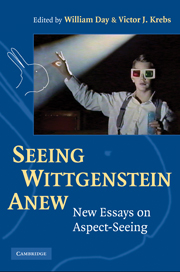Book contents
- Frontmatter
- Contents
- List of Contributors
- Acknowledgments
- Abbreviations of Wittgenstein's Works
- Seeing Wittgenstein Anew
- Introduction: Seeing Aspects in Wittgenstein
- I ASPECTS OF “SEEING-AS”
- II ASPECTS AND THE SELF
- III ASPECTS AND LANGUAGE
- IV ASPECTS AND METHOD
- IV.1 Therapy
- 11 On Learning from Wittgenstein, or What Does It Take to See the Grammar of Seeing Aspects?
- 12 The Work of Wittgenstein's Words
- 13 On the Difficulty of Seeing Aspects and the “Therapeutic” Reading of Wittgenstein
- IV.2 Seeing Connections
- Appendix: A Page Concordance for Unnumbered Remarks in Philosophical Investigations
- List of Works Cited
- Index
13 - On the Difficulty of Seeing Aspects and the “Therapeutic” Reading of Wittgenstein
Published online by Cambridge University Press: 05 June 2012
- Frontmatter
- Contents
- List of Contributors
- Acknowledgments
- Abbreviations of Wittgenstein's Works
- Seeing Wittgenstein Anew
- Introduction: Seeing Aspects in Wittgenstein
- I ASPECTS OF “SEEING-AS”
- II ASPECTS AND THE SELF
- III ASPECTS AND LANGUAGE
- IV ASPECTS AND METHOD
- IV.1 Therapy
- 11 On Learning from Wittgenstein, or What Does It Take to See the Grammar of Seeing Aspects?
- 12 The Work of Wittgenstein's Words
- 13 On the Difficulty of Seeing Aspects and the “Therapeutic” Reading of Wittgenstein
- IV.2 Seeing Connections
- Appendix: A Page Concordance for Unnumbered Remarks in Philosophical Investigations
- List of Works Cited
- Index
Summary
The distinctive character of Wittgenstein's manner of writing, early and late, must play an important role in accounting for the diverse ways in which it has been approached and engaged. Indeed, there is arguably no other philosopher about whom the question of how to approach his texts – how to understand their aims, methods, modes of criticism, compositional structure, and the like – is as widely regarded as decisively important to a correct appreciation of what they say, and as perennially a matter of dispute. In recent years, however, something approaching an orthodoxy concerning this matter has begun to emerge among interpreters of Wittgenstein. Informed by his remark that “there is not a philosophical method, though there are indeed methods, like different therapies” (PI §133), this approach to his work has been designated “therapeutic.”
A useful account of this “therapeutic” reading is offered by Alice Crary in her Introduction to The New Wittgenstein – a volume of essays the editors regard as exemplifying this approach. For my purposes at this point, the following three contrasts with what Crary calls “standard” approaches to reading Wittgenstein provide a sufficiently accurate, if general, sense of its nature. First, “standard” readings of Wittgenstein understand him to be addressing meaningful philosophical claims and to be showing them to be false, misleading, incomplete, or in some other way unsatisfactory.
- Type
- Chapter
- Information
- Seeing Wittgenstein Anew , pp. 268 - 288Publisher: Cambridge University PressPrint publication year: 2010
- 4
- Cited by



